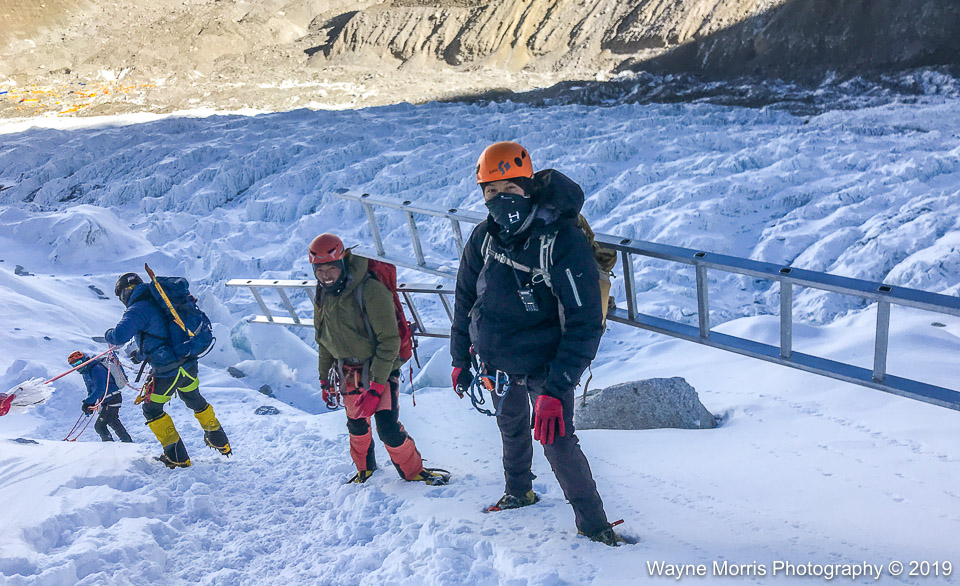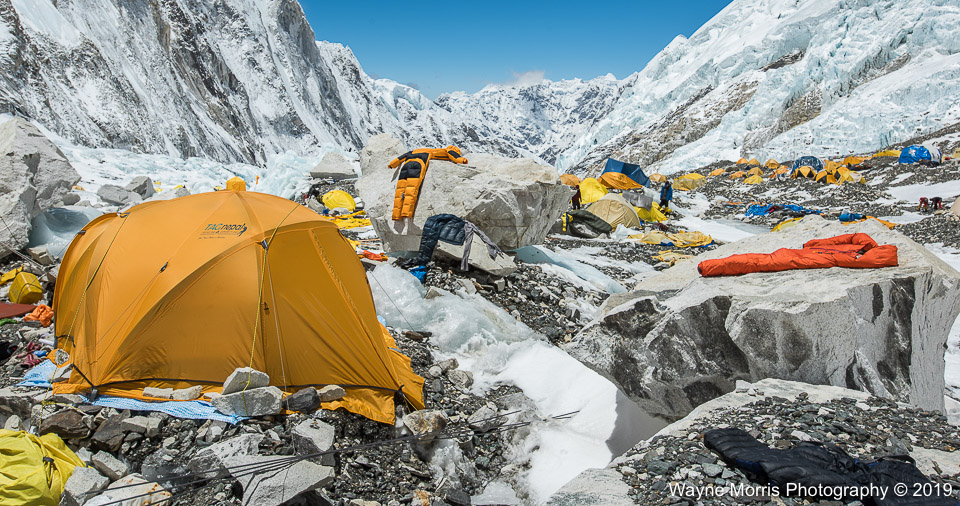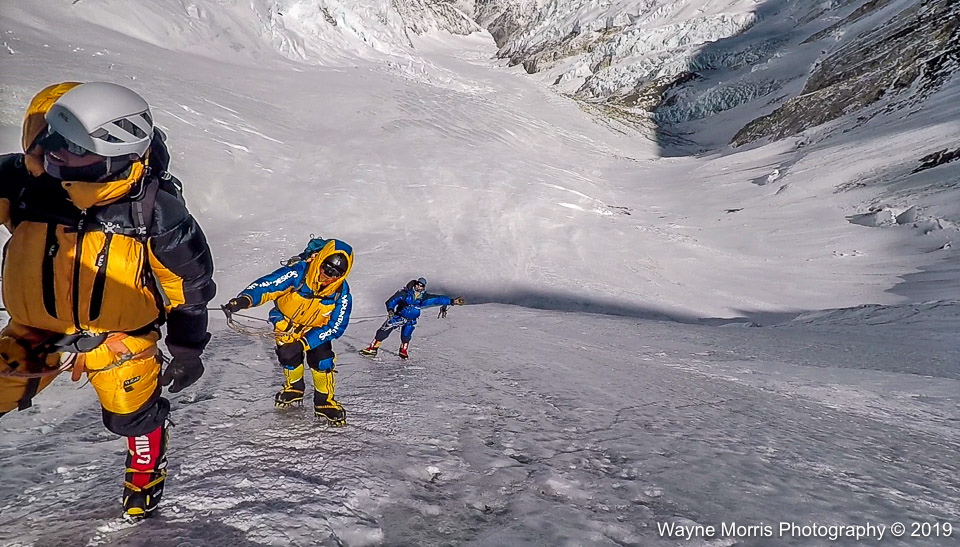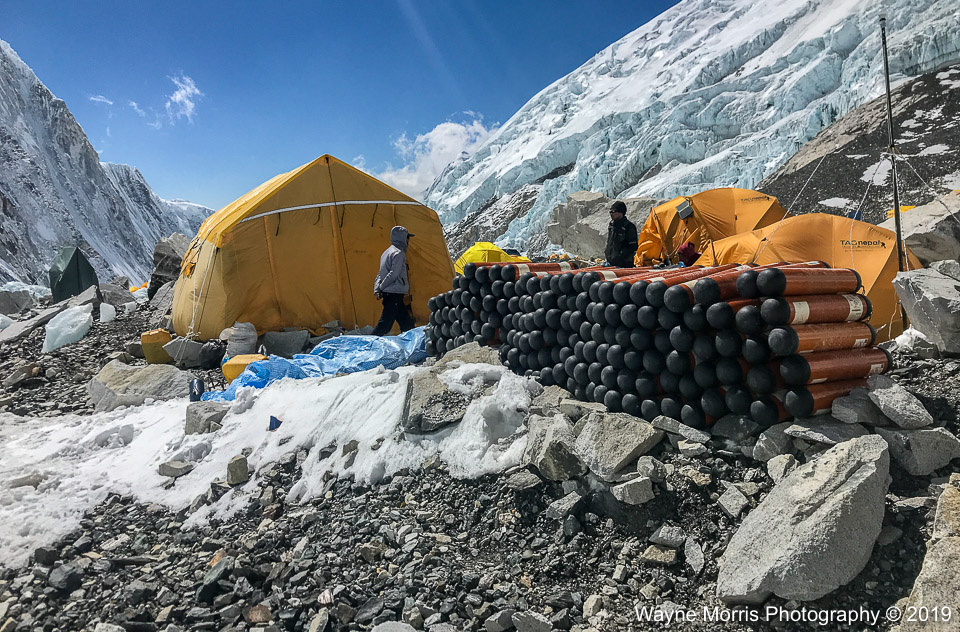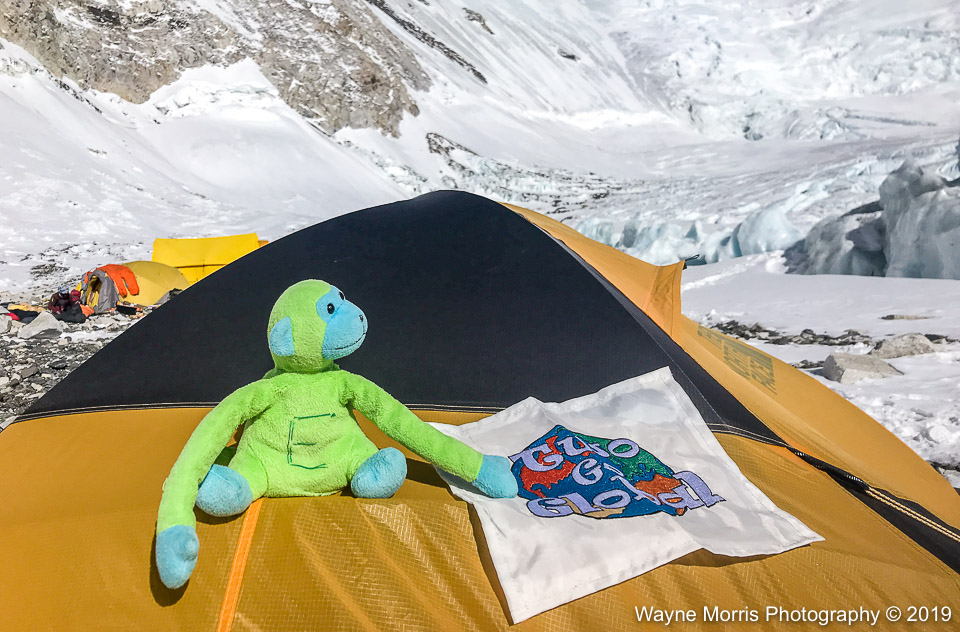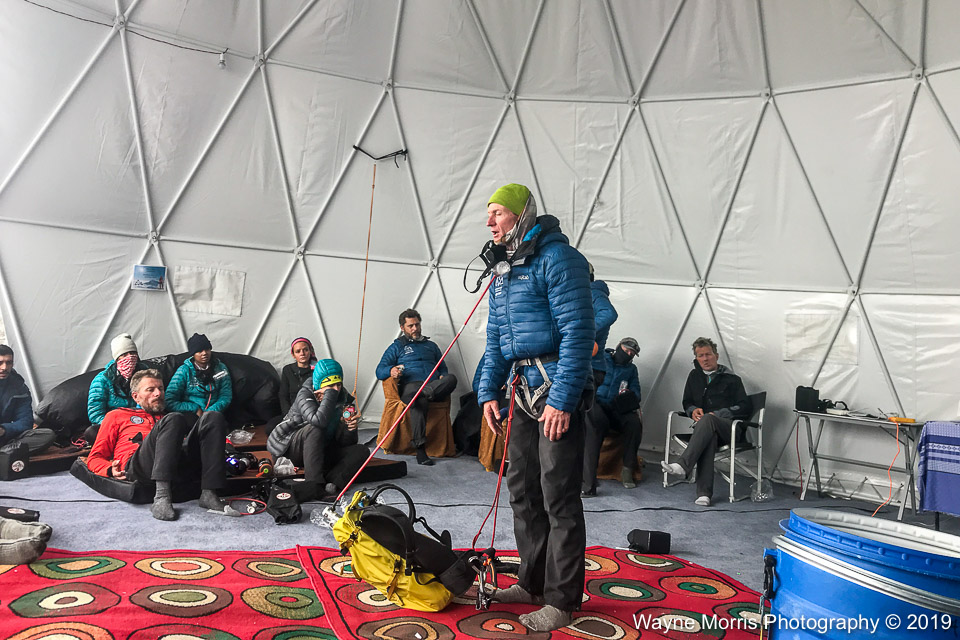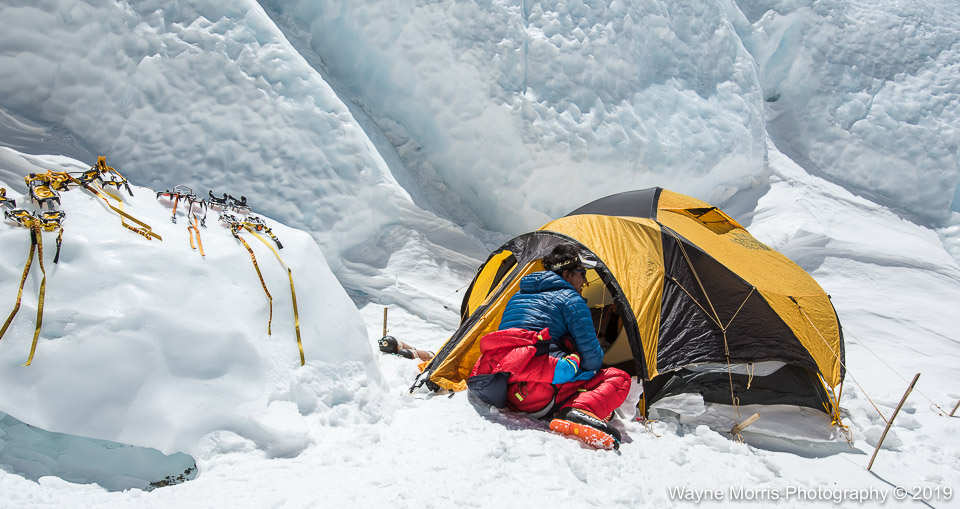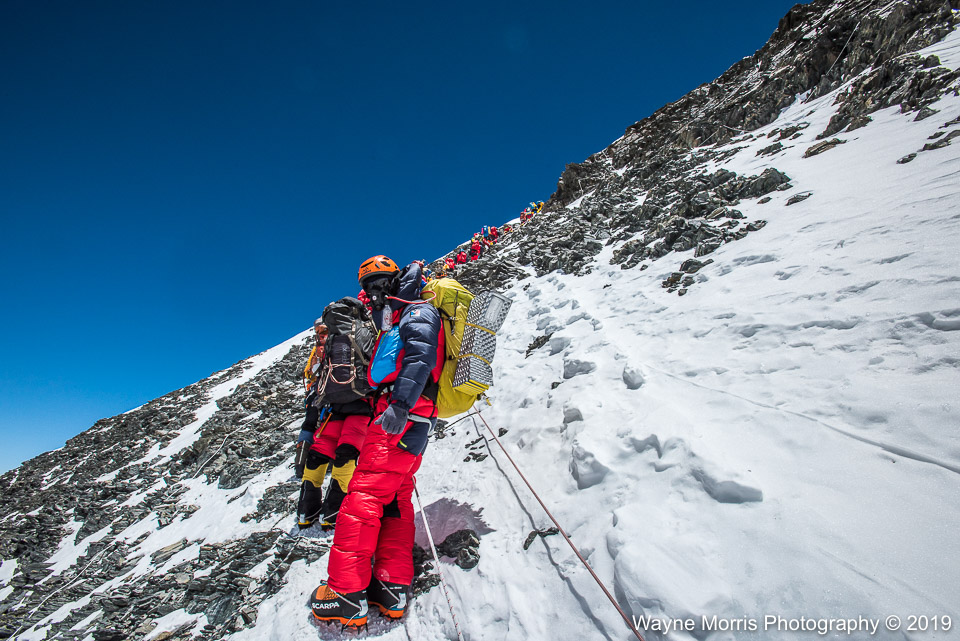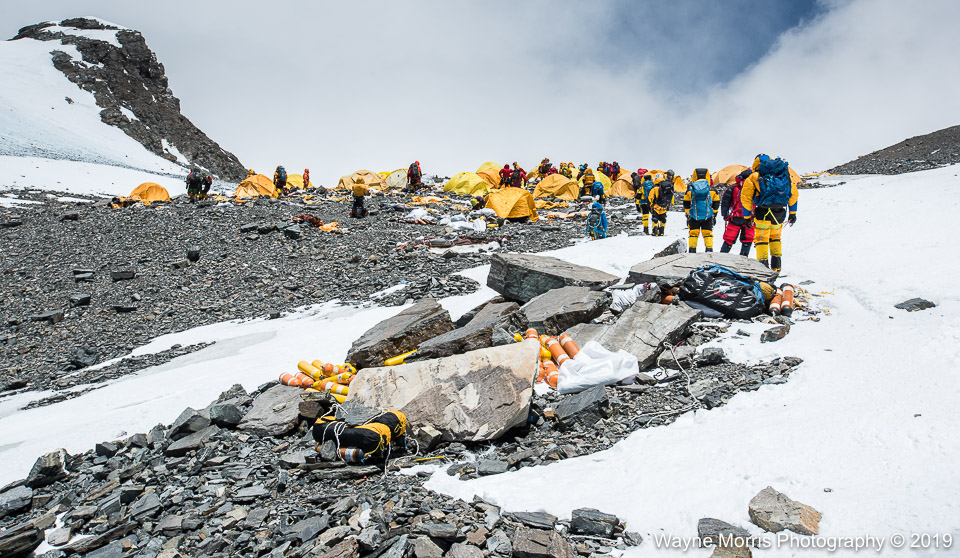Sitting watching Free Solo in our heated dining tent, hands sweating once again, was a welcome distraction from the snow swirling outside. Everest basecamp weather is fickle at best, the mornings so far being bright and sunny, sometimes annoyingly hot, whilst the afternoons meant clouds and sometimes snow. We had rolled in 2 days ago with the final thirty minutes walk weaving through camp after camp excited about arriving at the TAG Nepal setup – Hamill had been raving and promising grand things since committing to Everest with Climbing the Seven Summits some six months prior. Being greeted at trekker rock (as far as mere trekkers are allowed to go) with orange tang and ginger biscuits was a sign of the hospitality to come.
Obviously extremely proud the TAG Nepal part owner, Tendi, showed us around; the cooking area comparable to a commercial kitchen, a food tent stocked to the hilt with fresh food, meats and everything in between, padded dining tents with carpeted wooden floors, executive tents, and the regular ‘cattle class’ tents. A comms tent, guides tents, staff tents and a huge cleared plot for the yet-to-be-built chill out tent just added to the CTSS oasis. This was so far removed from the IMG setup some 14 years ago (probably even in 2019)! The majority of the clients opted not to pony up the additional Dollars for the exec package instead making do with Tendi designed South Korean built individual tents complete with padded insulation, eight inch mattresses, goose down pillow and more than enough space to empty the contents of two loaded duffel bags. The problem with this lavish setup could well be our reluctance to ever leave for the upper mountain!
Hamill had lived up to his promise on this one – disappointment was impossible, every conceivable whim taken care of and no expense spared!
Moving up to 17,500 ft came with its issues, mostly in the form of mild headaches and the infamous cough. Each morning was a battle to get out of the negative forty sleeping bag for bladder and pee bottle emptying, combined with snot rocket phlegm removal from the nightly buildup. Within an hour the early morning grogginess, assisted by copious amounts of coffee, subsided enough to tackle another miserable day playing in the Himalayas.
Following a basecamp rest day it was time to make our first foray into the lower realm of the Khumbu icefall for further gear setup options and training. Tossing snowballs at the highly experienced Sherpa guides and fellow climbers as they rappelled the vertical terrain turned out to be far more fun! This would be the limit to our early icefall escapades as prior to the CTSS Puja ceremony our Sherpas will not enter the icefall proper – climbing gear needs to be blessed, beer needs to be consumed and we all need to be smeared with flour, all whilst a monk from a local monastery sits chanting to ensure we will climb safely with a happy ending!
Was the mid morning furnace heat a sign of things to come up in the Western Cwm? Lets hope so!
From basecamp the Khumbu icefall looked as impenetrable as it did fourteen years ago, only this time instead of over one hundred ladders precariously perched across yawning crevasses and vertical faces there were supposedly less than ten. Bang goes all those classic photos looking down into an abyss whilst hanging out in the center of four ladders lashed together! How much easier could Everest become? The icefall seemed to have calmed down a little over the years but what hadn’t was the continuous thunder of avalanches as another monstrous piece of ice releases from its unstable face – this doesn’t get any less daunting! We were soon going to have our first venture into the icefall but before any of of our local and international team could tackle the huge tumble of ice blocks we and our climbing gear needed blessings from a lama.
Our Puja ‘blessing’ ceremony was an amazing affair, complete with over three hours of Buddhist chanting, Sherpa dancing, and our fair share of chang and San Miguel. One of our climbing Sherpas, also a Buddhist monk performed the Puja which looked very much like a well executed performance; if only we knew better why liquor was poured into a number of cups, followed by rice and numerous other food items, a sheath of juniper waved over the concoction, a beating back and forth of a small drum, then the entire thing repeated. It was clinical and each Sherpa involved knew exactly their role. At various times throughout the ceremony Sherpas, climbers and everyone involved threw small amounts of rice into the air, sometimes backwards over their heads, sometimes forward onto the lhapshu (the square rock built centerpiece decorated with offerings including food, drink and various ceremony articles). At some point towards the end of the chanting a small amount of tsampa, a flour like powder, was handed around with an exchange of good luck as it was smeared over others faces! Finally the Sherpa dance came, a fun time where everyone got involved in the foot stamping, beer chugging, event. I remembered these moments as if they were yesterday.
The gods would now be happy and allow for safe passage on the mountain.
The plan of attack now we had nothing standing in the way was a recce into the icefall followed a couple days later by a three night move up to camps 1 and 2. Exciting times! With the CTSS camp perfectly located a few minutes from ‘crampon point’ we were fully kitted to tackle this infamous obstacle to the upper mountain. The icefall becomes steeper the higher the ascent so in the lower reaches it was time to gain familiarity with ascending and clipping in and out of fixed lines, before making sure that none of these were skipped in the significantly more dangerous sections higher up. It was definitely more sketchy the last time here! What we didn’t have in precarious situations was made up for in the bottlenecks encountered at all of the steep/ vertical sections – it seems like everyone was in the icefall at the same time doing the same things. Only difference was that we were self acknowledged experts and I for one very impatient!
Overall the four hours was incident free, a complete blast and it felt great to be back on this adventure of a lifetime. Tenji, our climbing Sherpa seemed more than happy with his team.
A couple more active days under our belts and the fun is about to begin! Yesterday, instead of being a rest day ended up with us hiking to camp 1 on the nearby mountain of Pumori – this gained us 1,725 ft in altitude and should have provided amazing views of Lhotse, Nuptse and the summit of Everest. Funny how the weather can throw a spanner in the works! We’d have to make do with glimpses and use imagination for the rest. Still, to be back at almost 19,000 ft felt good and wouldn’t do any harm at all to our acclimatization schedule.
Our small team of 4 made comfortable work of the hike, none of us suffering from anything more than the occasional slide whilst descending! Rejoining the EBC trail with a spring in our step, skipping past puffing and panting hikers, felt good. It’s amazing what 5 nights at 17,400 ft does for the body. Fourteen years ago 60 nights was our duration at EBC, a little on the extended stay side!
Moving forward a day it was time to get some ‘crevasse-less’ ladder crossings done. Our Sherpa team lashed 3 together and demo’d how not to fall, a skill definitely worth knowing for the days ahead. As usual this bought back memories, only back then the number of ladders exceeded a hundred and a couple of team-mate clowns wouldn’t have thought twice about shaking the ladders or pelting you with snowballs!
Due to icefall reports of vertical ladders immediately followed by vertical ice it was also necessary to throw in some jumaring up a similar face, if not slightly overhanging. This was a blast even if it did redline the heart rate! Kicking in steps whilst trying to haul the body up a face with a mechanical ascendor preventing a fall will be a much needed skill. Once again this went without a hitch, providing a confidence boost for the following days trip through the Khumbu icefall and up to camp 1.
We now have 3 nights away from basecamp taking us through the icefall where we will spend a night at C1, the next day hiking through the Western Cwm where we’ll tag C2 and return to C1. The final night will be spent up at C2 before returning all the way to the luxuries of basecamp and it’s Big House.
Bring on 3am…
Writing this latest Everest update at 5.30am its hard not to feel for the Sherpas hauling staggering loads through the icefall on this bright but cold early morning, all to cater for every whim of a couple hundred relatively wealthy Everest and Lhotse climbers. From my comfortable vantage point it looked like a constant stream of ants, most making the journey to supply the intermediate camp 2 and prep for the loads that will need to be hauled to higher elevations once the fixed lines have been installed by the various team Sherpas. The ‘ants’ have probably been on the go since barely after midnight to avoid the collapses that are a common occurrence in the infamously unstable chaotic icefall. Whereas we mere mortals struggle to get our pathetic barely loaded selves up from Everest basecamp to camp 1 in a single push these super heroes are likely carrying in excess of 100lbs, but not only that are totally ignoring camp 1, instead continuing on through the Western Cwm to the upper mountains intermediate camp.
Whereas the icefall has been like a highway for the past few weeks, constantly fixed by the Icefall Doctors as it struggles down from the upper mountain, it was our first time to tackle it in its entirety following the jumbled mass all the way up to camp 1. On this foray we’d be spending a couple nights there and a further night at the larger more equipped camp 2 sitting almost at the foot of the daunting Lhotse Face. Getting up to and sleeping at 21,300 ft will be a big deal and assist in the creation of bucket loads of red blood cells, the driving force behind our ability to gain access to the oxygen depleted world above.
Whilst nothing is guaranteed cold does mean better, justification for our 4am departure into the icefall (we’ve heard and seen regular avalanches both day and night). No traffic jams, a couple of single ladder horizontal crevasse crossings and similar vertical setups – this was absolutely nothing compared to fourteen years prior when we had considerably more than one hundred ladders scattered between EBC and camp 2. Being in the middle of a highly flexing five ladder system is hairy to say the least, then add team mates who like to shake said ladder system! The biggest hurdle was three ladders lashed together with an icy overhang, a test to get the heart racing but nothing that couldn’t be maneuvered past. Camp 1 sat within thirty minutes from the top of the icefall and other than spectacular views was basically there only as an acclimatization stop en route to camp 2. Our team of three lay spent on sleeping mats outside of the blisteringly hot tents whilst our amazing climbing Sherpa, Tenji, prepped lunch, drinks, pitched a couple of tents, and generally made us look very inferior!
The aim of the next couple of days was to get high and sleep low so a quick jaunt up the Western Cwm to camp 2 was the way to go. With elevation being only 1200 ft higher it would seem to be a pretty comfortable hike but throw in the towering mountains of Everest to our left, Lhotse ahead and Nuptse to our right and we were in a high elevation oven the entire way. One foot in front of the other, breath, another foot, breath, repeat, and an hour later the tents of camp 2 came into view. Not sure who’s bright idea it was to make the CTSS camp the furthest possible away, at least that was the initial thought. Although a little demoralizing when heading up from camp 1 this would make an easy roped up walk to the base of the next obstacle, the Lhotse Face on the next rotation. The almost whiteout return not only cooled things down but was an important test in the resilience of camera and mount – having the bulky Nikon D810 and lens securely buckled to the fancy backpack strap worked flawlessly in good conditions but throw in snow, add a little cold and the small red button that releases the camera freezes solid making it impossible to remove the camera for photos or safe storage! Time to reconsider.
Our final day prior to a basecamp return would see us retracing steps to camp 2 only this time the heavier loads and a 21,300 ft nights sleep would step things up just a bit. With current weather patterns being fairly predictable the same hot weather pummeled us again before the afternoon clouds and snow rolled in forcing a retreat to the almost fancy dining tent – if this was the worst that we’d have to cope with then hopefully exciting times lay ahead over the coming few weeks. Being able to see the dots of the rope fixers on the steep Lhotse Face set focus on the next rotation. With nightfall came the chance to once again become horizontal, only this time instead of the usual fourteen hours or so the need to avoid the heat causing icefall instability we were due up before daylight. For me this came non too soon, a tumultuous nights sleep caused by the thin air meaning that as soon sleep came I was instantly awakened by the lack of oxygen – this continued all night, a problem that best not persist as we go higher!
Making our way back along the Western Cwm in the early morning cold was a blessing, unfortunately the precariousness of the situation showing through as we followed the main packed trail across the previous nights avalanche debris. Ice blocks that would wipe out anyone in their path were strewn around as an unwelcome reminder! Also, in the icefall it was obvious how things had changed; at least one of the building size ice blocks having given way to precarious positioning. Everest is like playing Russian roulette for sure!
Not a whole lot going on here at Everest basecamp other than the usual avalanches, eating, and trying to stay bug free. Yesterday was a full on rest day with the Free Solo rock climbing documentary on in the evening – after watching that it should be no big deal to head through the icefall without clipping in to anything! Ummm, maybe not.
Just to keep us active and make sure those red blood cells keep reproducing a three hour hike up towards Pumori camp 1 was the order of rest day two. Unlike the last hike up Pumori, on this occasion we were served up stunning views of the tallest mountain on the planet, coupled with one or two pretty significant others! Everest seemed to tower above everything else, its black triangular silhouette looking completely unobtainable, yet in a couple of weeks it will be open for business. Its usual lenticular clouds and 100mph winds didn’t seem to be present, hopefully a sneak preview of how it can behave on a good day!
Another rest day coming up tomorrow followed by the final and most important of the acclimatization rotations. Five or six days on the mountain primarily using camp 2 as the jumping off point to the Lhotse Face. A partial assault on its lower slopes with the goal being to tag our 24,000 ft camp 3 site a day or two later. This should put us in perfect shape for a weather opening a week or two later.
Still feeling in great shape, the usual coughing with some pretty cool looking snot rockets. No headaches whatsoever, no Diamox, no loss of appetite, and as long as freshly made filter coffee remains available certainly no thoughts of quitting!
This should have been our penultimate mess with death in the Khumbu Icefall; global warming and the heating, shifting and collapsing of the house size ice blocks giving us good reason to be on the trail by 3.30am whilst temperatures are at the lowest. Funny that we usually hear a prolonged avalanche or two around that time! As is typical due to glacier instability the Icefall Doctors had made some tweaks to the route, an extra ladder or two here and there, with at least one precariously balancing by a couple of inches each side – on rotation one we had leapt across that very same ‘slightly narrower’ crevasse! Camp 1 should have come into view within 6 hours if the previous time was anything to go by – previous bests are meant to be broken and our new FKT would bring us in a full 70 minutes quicker in 4:46. There’s something to be said for a good acclimatization program!
Pretty much the biggest slowdown in the icefall are three vertical ladders lashed together with an overhang; nothing challenging but potentially extremely time consuming with the sheer number of Sherpas making the journey between camps and the so-called ‘mountaineers’ who have no technical idea, are too unfit, or scared shitless. Fortunately on this rotation a sign had been placed at this obstacle… ladders for ascending, rope rappel for descending. We could see the black rope dangling 50 ft from above, no one using it but looking like a whole lot of fun when we head back down. For now we had to continue up, clipping in and out of the fixed lines whilst following the easier terrain that would see us eventually pop out into the Western Cwm.
We had made Camp 1 at 8am and in an ideal world would have preferred to refresh with Masala tea, rest for a while and head straight on up the additional three hours to the far more civilized Camp 2. Instead we wiled away the day whilst soaking up the sun and counting down to the next meal. With no dining tent we’re left with eating Mountain House or some other branded mush in two person tents filled to the hilt with oversized down-filled sleeping bags and jackets. After passing through on the first rotation Camp 1 should be a mere stopover en route to the upper mountain!
Not really a boredom day as there’s no way to possibly feel that way with huge snow covered mountains in every direction but we were glad to move on up. The 6am temperatures were another story! The problem with the route up to Camp 2 is the heat in the Western Cwm – the higher the sun gets in the sky the more miserable and escape-less it becomes. We could either suffer in the early morning cold or mid morning heat! Once again we reduced our rotation one time substantially, making short work of the undulating and fun crevassed sections before moving on to the roped up hour long grind of the furnace. By now the sight of the lower Camp 2 tents were visible, still some way off from the CTSS mini town. Psychologically the final 45 minutes sucked; plenty of loose scree covered ice that barely justified crampons but made for a slippery ride without, the idea that each small hill we poked over was home never materializing, still the end finally came.
Camp 2 sits a little over an hour from the base of the Lhotse Face, our next port of call in the acclimatization process. This mostly steep ice covered face is a thrill to rappel down but not such a joy to clamber up, especially in an ungodly cold hour! Right now that was for the following day, or was it? We had settled in to Camp 2 nicely, made an extra walk almost up to the bottom of the face gaining an extra 600 ft in the process and then settled in for dinner and the Sherpa/ Guides meeting. This included the weather forecast for the upcoming days. We new there was some stormy activity in the Bay of Bengal which was destined for the Everest region but had every belief it was a couple days off – the ominous news coming out of basecamp that we had to descend the following day was not welcome! Surely we had enough time if we left early to at least tag our Camp 3 and make it back down!
It was not to be and all hopes aside we were destined to make a further rotation after the possibly, maybe, not at all unsettled weather. On our descent all we could hope was that the teams still heading up would get a good dumping of snow whilst we relaxed in basecamp luxury! The anticipated 50 ft rappel did in fact turn out to be a blast, if not a little nerve racking for the first few feet. There’s something about dangling mid air with a vertical overhanging ice face feet away as you regulate your descent by the amount of kink applied to a rope! As usual with all times on this rotation the descent was significantly faster than the first time, a surefire sign that we were becoming accustomed to the considerably thinner air.
Another three full rest days under our belts allows plenty of time for relaxation and eating, probably in the opposite order, but at least on this occasion powerful Bay of Bengal cyclone Fani was to blame. Had this system not materialized we’d now be down valley waiting for the weather gods to allow access to the upper mountain and summit. As it is we now have to head back up, another foray through the newly snow covered Khumbu icefall before being tortured in the Western Cwm furnace – instead of spending the night at Camp 1 we’ll zip right on through to the recently decimated Camp 2. Fani apparently did a pretty good job on those teams that ignored her warnings and thought it a better idea to be at 21,000 ft instead of 17,400 ft. Over the last couple of days we could hear the freight train wind up high whilst we hung out with all the luxuries of basecamp.
Funny how if you read reports from the team owners then it was a light breeze with a sprinkling of snow, however the occasional team member update makes it out indicating otherwise! Our more believable reports specified that over 100 tents were damaged or destroyed in the 70+ knot winds, 2-3 feet of snow was dumped in the Western Cwm, and lives were made a misery for a couple of days. Its nice to be involved with team management who know how to read a weather forecast!
The really crappy conditions hung around for only a couple of days, the change from the surrounding whiteout to full visibility and sunny blue skies like a light switch – we go to bed seeing nothing and awake to what we’d become accustomed to. Being able to sit outside the dining tent at 6.30am, freshly brewed coffee in hand, looking up at the icefall once again just couldn’t be beat. There was no need for us to be breaking trail, or putting ourselves in harms way with the newly created avalanche risks so staying back an additional day made sense. It seemed that the vast majority of teams stayed put at basecamp, the complete lack of ants in the icefall meaning that tomorrow would see an influx of Sherpas and climbers heading up. Love the anticipation of probably having to wait at all the ladders and vertical ice walls!
Its exciting to think that the next time we’re back in basecamp will be to wait for optimal summit conditions.
Already sleep deprived the added midnight noise from crampons digging into the icy trail that meanders through Camp 2, bang through the middle of our tents, was the icing on the cake. Sherpas carrying oxygen loads from the various teams up to the South Col bypassing Camp 3 were the culprits, probably some of our CTSS boys in the mix too. It was hard to imagine being outside of our double walled tents and -40 sleeping bags in the frigid night time conditions on the way to the Lhotse Face; the steep blue-ice barrier preventing access to the rocky Yellow Band, Geneva Spur and the Col itself!
This was our final rotation that would hopefully provide the necessary acclimatization for the almost oxygen less world above 28,000 ft. Due to weather we were having to return through the icefall once more to tag 23,000 ft Camp 3, our high point before the summit. Whereas in 2005 Team Green Gibbon slept on oxygen at Camp 3 there are arguments both for and against, the CTSS team decision being to just tag it. Sleeping at Camp 2 is hard enough so not to spend a night higher was a good call.
Team Tenji had decided we were strong enough to skip Camp 2 on this rotation, instead tackling the Khumbu icefall and continuing on through the Western Cwm to the more ‘luxurious’ of the upper camps. Once again we were lucky in the icefall and only had people to pass in the lower sections, and once again we reduced our hiking time by a further 15 minutes – whilst not substantial we all felt the time was significantly slower. Acclimatization doing it’s thing! My start to the day hadn’t been one of the better ones but being forced to wait at ladders and behind other climbers did the trick; energy levels and desire increasing the higher we went. Keeping motivated, strong and healthy for such a period of time is extremely difficult, then throw in altitudes where the body cannot fully repair itself and Everest becomes a big proposition. The climbing part is easy!
Topping out at the wanded site of our Camp 1 felt good, no dread about heading straight on up the Cwm. Camp 1 had been purposely buried a few days earlier so as not to have been flattened in the fallout from the recent Cyclone, a good decision after seeing the additional snow on the mountain. No infrastructure meant no masala tea or chilling in a cook tent so we pretty much breezed right on through. Another three hours later saw us arriving at the uppermost setup of the extended Camp 2, also mostly flattened with the exception of the cook and dining tents, the latter used by a handful of Sherpas for sleeping during the storm. A quick conversion of the large sleeping tent back into a dining tent, a long table down the center littered with flavored drinks, chocolate, crap instant coffee, and biscuits, and we were taking in the necessary food and drink to recover from this extended 8 hours of energy exertion.
Whilst our home for the next 3 nights provided a level of relative high altitude luxury it also bought sleepless nights, the additional elevation over Camp 1 being enough to cause nights of continual waking in search of a few more O’s. These never materialized, and neither did the gasps for life! By the third night, as the acclimatization process continued its job sleep did become more sustained, still not reducing the desire to return to the thick air of basecamp.
Somewhere in the middle of the foray up to Camp 2 was the necessity of making it up to the dizzying heights of Camp 3; tiny orange, yellow and red dots precariously perched high on the Lhotse Face – this would be our highest elevation reached at 7,000 m, or 23,000 ft prior to the summit push. Sharp crampons and down suits were the order of the day, the hard blue ice barely allowing steps on the face and occasional gusty winds keeping us comfortable. Distance was minimal but the sheer steepness made this a demanding 4 hours of jumaring on an unrelenting surface. Hopefully the next time through in a week or so the kicked in steps will be slightly more substantial and we’ll get the face pretty much to ourselves again – passing others on steep icy terrain, whilst possible is not ideal and comes with definite life threatening risk!
Following on from tagging Camp 3 it was all about rest, a full day of boredom at Camp 2, then sitting it out at basecamp whilst a rope fixing Sherpa team secured the route to the top of the world. This was dependent on weather and with the forecast showing strong jet stream winds on the summit for a few days wouldn’t be happening just yet.
Aside from stuffing as many junk food calories and liquids down your throat as possible the acclimatization process is by far the most important schedule on Everest and all other big hills. This comes in the form of rotations up and down the mountain, slowly gaining altitude and creating oxygen rich red blood cells all the time.
Due to the inherent risk of the Khumbu icefall, from afar the insignificant looking stretch of ice blocks reaching uphill between Everest and Nuptse, the less exposure to its volatility the better! For this reason our schedule involved acclimatizing on nearby 20,000 ft Lobuche Peak, a far safer and more demanding lump of rock. The week spent going up and down this mountain should have meant that we would only travel through the icefall twice before making a summit bid. Lobuche, as well as being safer, offered far steeper terrain and more real mountaineering fun than anything the icefall could have provided. Rotation one complete!
Moving further along valley to Everest basecamp, the formidable icefall still didn’t look anything too sketchy or dangerous. It wasn’t until deep inside its labyrinth of trails that you could truly appreciate how easily things could go disastrously wrong. The SPCC, or Icefall Doctors, did everything possible to create a pathway gradually heading uphill until popping out at the foot of the Western Cwm – this would almost entirely be fixed with ropes, the crevasses that couldn’t be jumped fixed with a ladder or more, and the faces that were too steep for steps secured with ropes for jumaring up. This was a moving glacier and however safe the Doctors made the route there was a continual threat of collapse!
Moving on to rotation two; an early start was the order of the day (as soon as the sun starts heating the ice blocks the more things become unstable), with us safely making it through the icefall topping out at the foot of the Western Cwm. Spending a night at a similar altitude to the top of Lobuche, making a hike up towards Camp 2, then spending a night at Camp 2 was the plan. Although only a three hour hike the Cwm sits between the giants of Everest, Lhotse and Nuptse, almost creating its own weather, and definitely creating its own heat – the place is like a furnace as soon as the sun rises! Leaving early on back to back days we strolled into our Camp 2 without any problems, the second occasion with the addition of an extra 600 ft of elevation gain to the foot of the Lhotse Face. Acclimatization at its best! A direct descent from Camp 2 back to basecamp would end rotation two and ensure that those new red blood cells would make basecamp life significantly more tolerable.
Now we should be one rotation away from waiting out the weather for a summit bid. For the third rotation pretty much the same schedule would be followed except an extra day to make it up to Camp 3 was added. We knew a storm was on its way but assumed that it was still wrecking havoc in the Bay of Bengal. Once again we took on the icefall, this time making it through over an hour faster – something to do with being further along in our acclimatization program! We spent a first night at Camp 1 before an early departure up to Camp 2, also in a faster time. Then the shit hit the fan with Hamill calling us all back in anticipation of windy weather hitting earlier than initially thought. Surely we had enough time to hit Camp 3, make it back down and then leave the following day for basecamp? Sorry, no can do! We were to return to basecamp early the following morning whilst camps one and two were dismantled by the CTSS Sherpa team. If we had stayed the extra day we would have indeed been fighting our way back down in inclement weather, not a good idea when above 20,000 ft.
As soon as conditions permitted we were right back at it, almost an extension of rotation three but we’ll call it rotation four. Our crew, Team Tenji, decided to skip Camp 1 and go directly from basecamp to Camp 2. Even with holdups in the icefall we still walked into Camp 1 faster than prior times and still made it up to Camp 2 no slower than before. This acclimatization plan was paying off for sure. Although pretty beat up the plan to tag Camp 3 the very next day was executed and four hours after leaving we were sitting on a ledge above 23,000 ft, higher than anywhere outside of the Himalayas, looking down valley to the tents of camps one and two and straight across at Cho Oyu and other Himalayan giants. After a boring rest day at Camp 2 we were heading down on our penultimate descent back to basecamp.
Three times up the lower flanks of Everest, three times safely down and an ascent of Lobuche and we were done with acclimatization. Now it was a waiting game for the jet stream to get the hell off the summit and allow us to utilize our newly formed red blood cells!
Having now been back from our final rotation a week it was time to think about going stir crazy! Still the timing wasn’t right, with rest days getting in the way of a 48 hour summit opportunity, and now wind that isn’t crazy strong but certainly not ideal. Currently the best forecast is May 22nd offering limited winds and a good chance for the mass of climbers to depart on the exact same day! Out of the 381 permits that were issued thirty’ish went for the summit yesterday and with an estimated quit rate of perhaps 20% the mountain could still be overly busy if all the teams decide to go at the same time. Ideally a hoax weather forecast is required to keep the rest at bay whilst we swing into action!
Since popping out of the Icefall the last time it’s not been a totally lazy period; Pumori high camp and another jaunt a little higher to Pumori camp 1 on the agenda. Both hikes followed the Everest trek out of camp before turning off at the foot of the 23,500 ft mountain that dominates the view from basecamp. However much we’d have liked to go above camp 1 conditions were far too risky with hanging seracs providing massive avalanche risk, one such avalanche wrecking havoc on Everest basecamp during the 2015 earthquake. All we cared about was wiling away a few hours and keeping those oxygen rich red blood cells generating!
When you’ve been at or above EBC for thirty one days small things float your boat but events such as the CTSS Big House bash are truly epic! Adventure and climbing celebrities from near and far were on the invite list putting this on par with the a-listers at the Oscars. A full day affair, it was time to deck out the huge dome Big House with a sophisticated heating system, high tech sounds, lounge chairs, giant black sausages and 10” thick mattresses – if the afternoon sun and enough body heat could be generated then the three crappy power hogging Chinese heaters wouldn’t be necessary! The CTSS kitchen crew put out an impressive spread of hors d’oeuvres, ample flask of hot drinks, and Hamill supplied the all important alcohol. Whilst limited to a couple dozen cans of Heineken, six bottles of Beefeater Gin and a sneaky half bottle of Mikes best bourbon it was enough to make a few people merry. From 4pm the guests started rolling in and the social event of the Everest calendar began!
Guys, gals, Sherpas, and Sherparettes from our very own CTSS, National Geographic, International Mountain Guides, Adventure Consultants, Alpine Ascents, Madison Mountaineering, and other guiding companies flocked to the epicenter of Everest basecamp. The invitees not making it were obviously too busy entertaining themselves at their mediocre camps! It was clear that everyone had a great time, with plenty of conversation and group photos flowing before the Sherpa community and their itchy feet dominated the dance floor. Participating in Sherpa dance never gets old with the same indistinguishable sounds and leg movements now as what Team Green Gibbon went through back in 2005. The three hours of entertainment went by far too fast and before we knew it everyone had vanished leaving the Big House in need of some TLC.
The questions now were who stole Hamill’s Woodford Reserve Bourbon and if our weather window of May 22nd would still exist in the next few days, conditions on Everest changing on a whim! Each day with the arrival of the new high tech forecast comes another days delay, the summit opportunity continuously being pushed out. Could this be a replication of 2005 when we headed up the mountain in very unpredictable weather at the end of May? At time of writing we leave basecamp on May 18th. Watch this space…
Unexpectedly I get to write this penultimate Everest update from seat 1A on Qatar Airways flight 755 from Doha to Atlanta; unexpectedly due to this being a business class seat and traveling in anything other than cattle class never happens! Ripcord Rescue Travel Insurance had kindly upgraded my home bound flight ticket as part of the insurance claim underway! It had been over a week and a mental blur since Team Tenji’s final departure from 17,400 ft Everest Basecamp, the time flying by with all the goings-on. I had been in search of Seven Summit number 7 (eight if Carstensz in Oceania is included), the grand finale of a twenty year quest to tag the highest mountain on each of the seven continents.
May 17th held up as our summit bid departure date, and so it was that the alarm went berserk as it usually does around 2.30am when heading up through the instability of the Khumbu icefall. With everything already high up on the mountain this felt like just another foray into and above the danger zone, almost a formality that our group of four had safely done a handful of times over the past month. This day would be no different, other than the fact that we were once again going to roll right on past camp 1 and continue to the far better stocked intermediate CTSS camp 2. None of us had any desire to be finished for the day and in camp by 8am, eating and drinking in tent vestibules, as is the way at camp 1.
Having an extra night at camp 2 ensured we had all the time in the world to make it there, brushing the heavily detoured icefall route aside once again leaving a leisurely high altitude hike in, out, around and across the crevasses of the lower Western Cwm. The difference between camps 1 and 2 was less than three hours with an elevation gain of around 1,300 ft. On this occasion the middle portion of the typically hot Western Cwm was typically hot once again but lacked the necessity of us all being roped together – the sketchy sections with open bottomless black holes were now somewhat roped! The final section was a shitty meandering moraine trail from extreme lower camp to CTSS 2, sitting at the far higher site closer to the bottom of the Lhotse Face. This part was never fun, heartbreak hill kind of not fun!
Well rested and with the short and mediocre looking weather window still appearing to be on our side it was time to hit the upper mountain. Our camp 3, a little above the majority of the Lhotse Face sites was a steady slog once reaching the beginning of the steep icy face. Within four hours we would be breathing bottled oxygen to sleep and tackle the terrain above 23,000 ft. As on the previous occasion the Lhotse Face wasn’t initially a big deal, that was until the first of the camp 3 tents came into view, triggering a process that in my mind the section was over. This battle with leg and lung shutdown, coupled with an overwhelming urge to drink, made the last couple hundred vertical feet a tough proposition! Coupled with the usual congratulatory group hug the priceless view back down towards camps 1 and 2, Cho Oyu and other distant peaks was mesmerizing and easily offset the fatigue feeling.
Although not completely necessary it was nice to get vertical for an hour breathing O’s, where even at a low flow rate the pure oxygen supplemented what was available naturally nicely. Based on todays late performance, or lack of, I guess it was kind of crazy even having the thought of making it to the South Col and beyond without oxygen assistance! Whilst it is possible to summit ‘naturally’ it has to take an entirely different breed, people like our climbing Sherpa Tenji or Ecuadorian superguide Ossie – truly badass. As usual whilst clients became horizontal our Sherpa team were busy erecting tents, melting snow for drinks, prepping meals and ensuring we had everything that was carried up from camp 2 – watching these superheroes hard at work after doing the exact same as what we had just done makes you realize how few climbers would ever get anywhere close to the summit of Everest without them!
Whilst none of this terrain was new to me having been far above the South Col back in 2005 it was super exciting to be leaving early the following morning on the penultimate climb before the final summit bid. We would be continuing on up the steep and never ending Lhotse Face, crossing the rocky Yellow Band before passing by the Lhotse high camp (and the dead climber just a few feet off the trail), followed by a quick traverse to the days final ascent up the Geneva Spur. Once at the top of that it would be an easy relatively flat finale to the massive open space of the South Col at almost 26,000 ft. Welcome to life in the Death Zone! All we had to do was put one steady foot in front of the other…
By the time of our departure there was already a long line of climbers inching their way up on the fixed lines high above us, tiny dots as they moved up the face and across the Yellow Band. I had forgotten how far the Lhotse Face continued on up beyond the camp 3 sites before making its turn left towards Everest! A couple of passing maneuvers, a lot of heavy breathing and we were sitting on the tiny ledge in the middle of the 3 or 4 tents that make up the Lhotse high camp taking in the necessary nutrition, the most noticeable view being the semi-naked corpse of the recently dead Lhotse climber. It’s interesting how numb people become up here, with this being only the third dead body I’d ever seen, one of the others being in the icefall back in 2005. You just walk on by not batting an eyelid, continuing with the job in hand!!
Nearing the far-from-technical Geneva Spur we were introduced to the first real lines; climbers, actually puppets with their Sherpas pulling on the strings, were in a conga line up to the lip that indicates the gateway to the South Col. Back in 2005 there was little snow cover and the fixed lines were installed at a far sketchier section, a section that we had to rappel down due to the steepness. What these people this time around were having a problem with was unbelievable – this should have been an indication of the traffic jams that would follow on summit day! Probably an hour went by as we moved at snail pace up the 45° incline, comfortable steps kicked in all the way, before topping out. Luckily hypoxia ensured thoughts regarding this absurdity were elsewhere and moving on up towards camp 4 one solid step at a time became a simple formality.
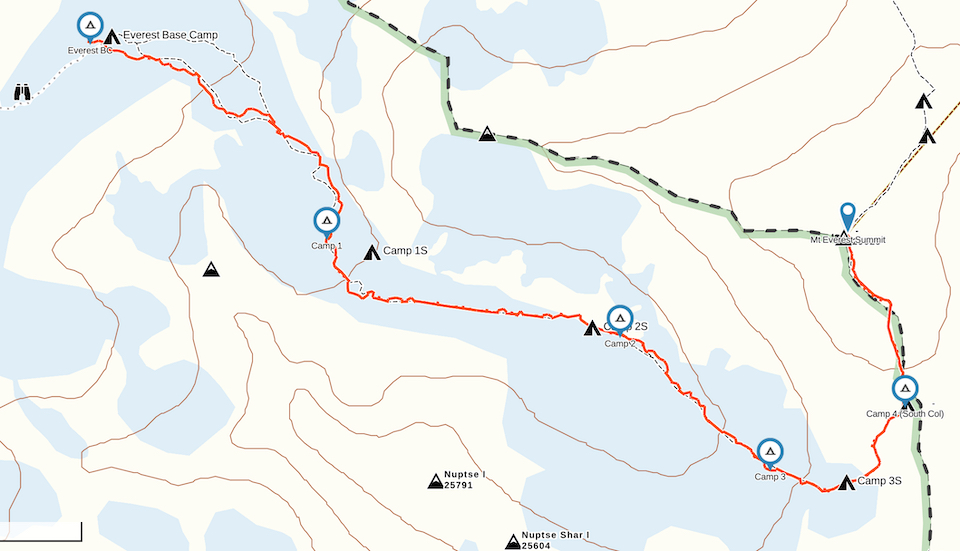
Summit Rotation
Basecamp to C2 – gain: 3,881 ft, altitude: 21,386 ft, hiking time: 8:56.59
C2 to C3 (Lhotse Face) – gain: 2,326 ft, altitude: 23,264 ft, hiking time: 3:52.10
C3 to C4 (South Col) – gain: 2,992 ft, altitude: 26,156 ft, hiking time: 7:18.16
C4 to Everest Summit Return – gain: 3,320 ft, altitude: 29,035 ft, hiking time: 14:57.34
Dates
April 3rd – May 23rd 2019
IMAGES
I think that with trial and error both my photography and website design are getting progressively better so hopefully these newer, better quality images will inspire you to get out there and travel. Click HERE to see more and if you like the content then feel free to comment.

















